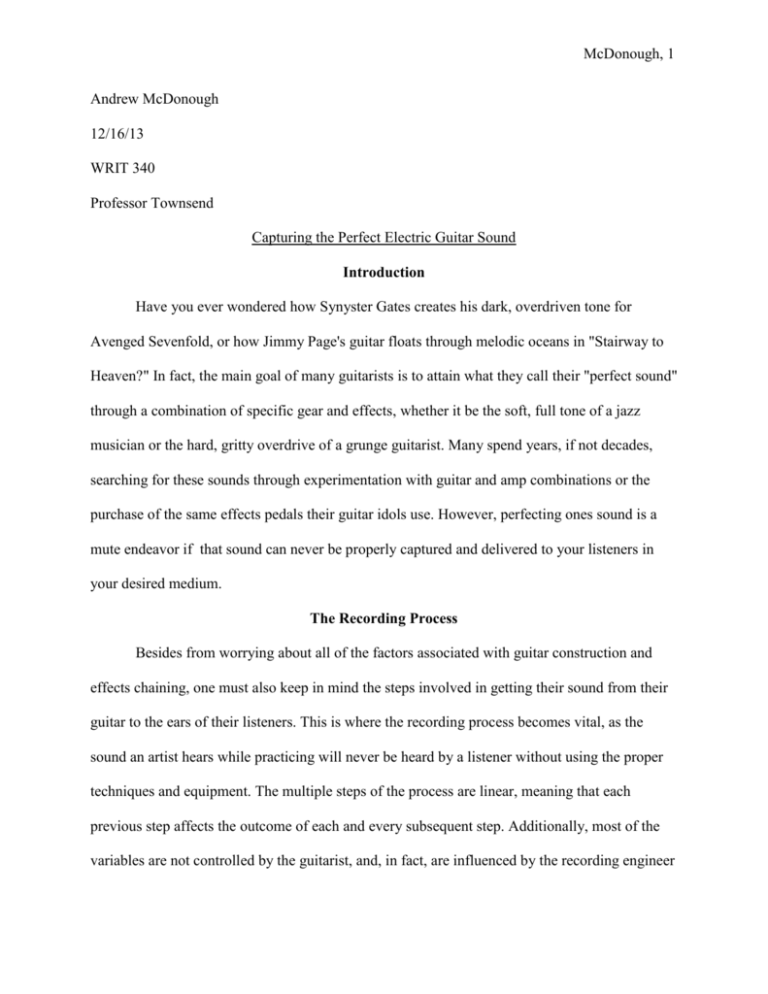McDonough, McDonough, Andrew McDonough 12/16/13 WRIT 340
advertisement

McDonough, 1 Andrew McDonough 12/16/13 WRIT 340 Professor Townsend Capturing the Perfect Electric Guitar Sound Introduction Have you ever wondered how Synyster Gates creates his dark, overdriven tone for Avenged Sevenfold, or how Jimmy Page's guitar floats through melodic oceans in "Stairway to Heaven?" In fact, the main goal of many guitarists is to attain what they call their "perfect sound" through a combination of specific gear and effects, whether it be the soft, full tone of a jazz musician or the hard, gritty overdrive of a grunge guitarist. Many spend years, if not decades, searching for these sounds through experimentation with guitar and amp combinations or the purchase of the same effects pedals their guitar idols use. However, perfecting ones sound is a mute endeavor if that sound can never be properly captured and delivered to your listeners in your desired medium. The Recording Process Besides from worrying about all of the factors associated with guitar construction and effects chaining, one must also keep in mind the steps involved in getting their sound from their guitar to the ears of their listeners. This is where the recording process becomes vital, as the sound an artist hears while practicing will never be heard by a listener without using the proper techniques and equipment. The multiple steps of the process are linear, meaning that each previous step affects the outcome of each and every subsequent step. Additionally, most of the variables are not controlled by the guitarist, and, in fact, are influenced by the recording engineer McDonough, 2 assigned to the recording session. Thus, it is important for the guitarist to communicate how he wants his guitar to sound for the engineer to properly place microphones and process the guitar recordings. There is a large amount of equipment and technology encountered during the linear recording process, so this article will briefly explain the major points. Audio Signal Path Amp Microphone Cable Recording Equipment Mix Playback/Speak er System Figure 1 Referenced: A. Garver The Amp: The choice of amp, although not normally regarded as part of the recording path, is the first piece of equipment standing between the guitar's electrical signal output and the conversion to physical sound. An important term to be familiar with when talking about audio and its reproduction is the frequency response of a certain piece of equipment. The frequency response is the output level of a device at different frequencies in respect to the original sound (i.e. the lows are exaggerated while the highs are cut). The speaker cabinet, or the enclosure that houses the speaker, will have a characteristic frequency response that will not be flat. This is due to the materials used to construct it, its size, and its geometry. As a general acoustic rule, dense, porous surfaces tend to absorb more high frequency sounds while non-porous surfaces tend to reflect sound and retain the higher frequencies. Additionally, the dimensions of the cabinet can create a resonance in certain frequencies, which means that a select number of frequencies will be amplified simply because of the layout of the cabinet. Thus, each cabinet will stress a McDonough, 3 different part of the sound, be it the middle or low end or somewhere in between, and create a different overall tone [4]. The electronics within the amp, specifically the type of amplification, will also play a big part in the coloration of a guitar's tone. The amplification circuit is usually all solid state Suggested Audio: Distortion through tube amp versus solid state amp. (meaning it uses all modern electrical components) or tube driven (meaning it uses a physical tube for amplification). When the gain, or volume added to the original input signals, of the amp is turned up, the input signal becomes too strong for the electronics or tube to handle and distorts the signal. This distortion is a common effect applied to modern guitar's, adding the crunch and bite to sounds all the way from Led Zeppelin to the Foo Fighters. A tube acts differently than solid state electronics in this situation, and adds what most consider to be a more organic tone [13]. There are also built-in effects included with almost every modern amp. These effects are usually part of a standard set, but, like standalone effects pedals, have their own unique sound. The most common included effects are called reverb, chorus, distortion (which adds a large amount of gain to the signal as explained before), and onboard EQ. These effects can be combined in Figure 2: Example Amp Head series to varying degrees in order to create the desired final sound of the guitar. The Microphone: The microphone used to capture the sound of your guitar is the most influential devices between your amp's tone and the sound that is eventually captured in the recording. Different types of microphones offer different frequency and transient responses. The McDonough, 4 transient response of a device is how fast it reacts to incoming signal, which is analogous to how fast one's reflexes are. If something is thrown at you at a high speed, the better your reflexes are the more likely you are to catch it. Likewise, the greater the transient response if a microphone, the more likely it is to pick up a very fast or short-lived sound signal [4]. To the right is an audio clip made using the common makes and models of the Suggested Audio: Microphone Comparison three types of microphones: dynamic, condenser, and ribbon. Listen to how each microphone, although in the same position, captures a slightly different sound. Additionally, different types of microphones have different sensitivities to sound. All microphones initially output a low level signal that needs to be amplified in order to be used by other devices. The initial, or pre- amplifier, used to accomplish this is called the preamp. The lower the sensitivity of a microphone, the smaller the initial signal it produces. Since the environment will always add noise to your signal due to electromagnetic interference in the electronics, a low sensitivity brings the desired signal closer to the amplitude of the noise, or what is called the noise floor [4]. Thus, in order to have the cleanest sounding recording, the microphone with the highest sensitivity should be used. There are trade-offs to this, however, such as the irregular frequency response of microphone types with better sensitivity. Table 1: Microphone Characteristics Overview Type of Microphone Dynamic Condenser Ribbon Frequency Response Erratic, depends on mic. Mids are flat. Almost flat, less lows Mostly flat Transient Response Sensitivity 3 2 1 2 1 3 McDonough, 5 Microphone placement is also vital, further affecting the frequency and transient responses of the microphone. To give a broad view of the subject, the angle of the mike towards the cabinet, the placement in relation to the speaker cones, and the distance from the microphone to the cabinet all effect the sound that is captured by the microphone [3]. However, there is a way around the traditional use of a microphone. Most high quality amps now contain a "direct out" output jack, which bypasses the built-in speakers and sends the signal, after it has been amplified and after effects have been applied, directly out of the amplifier. Although it can be argued that this outputs the "true" output signal of the guitar lacking the added color and specific frequency response of the amp's speaker, many artists prefer the tone added by their amp and opt out of using this method. Frequency Response at Different Angles for a Condenser Microphone at 30cm Figure 3: Source-2011C Twin Diaphragm The Cables: Most guitar players use any 1/4" unbalanced cable they find lying around as their guitar cable, which i s the standard cable used to connect a guitar and amp. While this suits jam session and practices, the signal to noise ratio, meaning how much noise or unwanted signal you pick up in your wires versus how much of the original signal you have, can become a serious issue in the recording process. This is because unbalanced cables inherently pick up external McDonough, 6 noise due to their construction, the opposite of the balanced XLR cables used to connect to microphones or TRS cables used to route audio signals. This external noise can be the "shhh" sound often associated with the background noise of a song or the 60 cycle hum of the adjacent wall Figure 4: TRS and 1/4" Unbalanced Cables Referenced A. Garver power socket [4]. Balanced cables get around this sound issue by carrying two copies of the signal they are transporting, one that is "hot" (+) and one that is "cold" (-). The hot and cold signal are inverses of each other, as one is flipped (made 180 degrees out of phase) within the electronics of the outputting device. For simplicity one can imagine two cosine waves, one starting at a positive amplitude and the other starting at a negative amplitude. As the signals run along the wire they both pick up the same noise, which for simplicity can again be a cosine wave. Once the signals get to their destination, the one that was flipped is flipped back, making the signals add together but the noise (which now consists of an in phase component and an 180 degree out of phase component) cancels. Additionally, the circuit formed by the cable (which has some capacitance) and a passive set of pickups (which have inductance) will naturally create a low pass filter while also bumping the middle frequency range. The effect is less and less high end the longer the cable is run, with a constant middle "bump" [11]. High end cable manufacturers focus on solutions to these problems, but sometimes the extra color added by the cable can constructively add to your sound and does not want to be "fixed." The maintenance of sound "defects" starts to be an overarching trend in the recording process. McDonough, 7 Recording Equipment: Additionally, all the equipment you run your signal through, from the preamp to analog to digital converter, adds its own characteristic sound to the signal. This is due to the complicated physics behind how electrical signals interact with device components, and allows each piece of equipment to slightly modify the sound as it passes through. These changes are further modified by the strength of the signal. As an example, a preamp can sound much different when it is turned all the way up to when it is only turned up half way. The changes are usually minute, but noticeable to a trained ear. An interesting example of this occurred in a loudspeaker factory in Scotland in the 1990's. In an attempt to find a common amplifier to use with the company's new line loudspeakers, they brought in recording engineers to listen to different amplifier and speaker combinations. Although the speakers were different sizes, they were constructed similarly and thus the engineers expected to find a single amplifier that would produce the best sounding audio output from all of the speakers. After conducting blind tests of each speaker and amplifier combination, a different amplifier was paired each speaker except for one case [10]. This exemplifies the slight variations in how different devices modify audio signal. Many recording engineers take advantage of these differences and discover their own favorite combinations of microphones, preamps, and gain staging (the amount of gain added at each "stage" the signal goes through) that yield their preferred sound. Mix: Now the analog sound is recorded into digital information and finally captured in a medium where it can be faithfully reproduced. Yet, there are still more options for modifying the sound even further. There are a few standard tricks used by recording and mixing engineers that produce Suggested Audio: Two mics panned center, then panned in stereo. consistent, positive results if desired. One of them is sending separate recordings of your McDonough, 8 instrument using different mikes to different speakers, usually sending almost all of one to the left speaker and all of the other to the right. This adjustment of how much output signal goes to each speaker (either left or right) is called panning [12]. Duplicating a single guitar track to make two tracks is another common method. Separate filters can be applied to each track to only let lower or higher frequencies through, and then they are panned left and right. This can make the sound of the guitar thick and huge, as the sound seems to come from all around. Filters can also be used to get rid of certain annoying or distracting frequencies in post-production to make a bass drum sound less tin-like or to cut out the 60 cycle hum mentioned earlier. Another use for duplicating tracks is adding effects to the duplicated track but keeping the original track the same, allowing the duplicated track with the effects to be dialed in however much is desired. This results in a fuller sound in contrast to simply applying the effects to the original track and essentially losing a portion of the original signal due to the effects processing [12]. While guitarists usually add effects much before mixing process, those same effects and more can be added while mixing. However, these effects will have their own characteristic sounds that will be different than the effect on the guitarist's amp or in his effects pedal. Thus, effects like added gain or reverb are usually configured before the recording process by the guitarist. For other instruments that do not have effects such as reverb and chorus right at their fingertips, they are added during the mixing process. The most common effects added during mixing are reverb to any vocal tracks present and compression to the drums and bass. Playback Device/Speaker System: The device your recording is being played back on can also drastically affect the sound of your instrument. All speakers systems have a characteristic frequency response just like the amps explained earlier, and this response is never McDonough, 9 exactly flat. Thus, the final conversion from digital audio to analog sound waves can further modify the tone of the resultant sound. The human ear naturally accentuates the middle frequencies, leading many manufacturers to add a built-in, permanent bump in the high and low frequencies in the hardware of their speaker systems [4]. Meanwhile, the mix of the song is done in a recording studio in the best possible acoustic environment using the best possible, flat frequency response speakers. Many times, the manufacturers permanent EQ detracts from the original mix of the song and forces consumers to listen to a modified version of the song. Conclusion Recently, the music industry has seen the development of new technology that has changed the way the industry works. The rise of home studios and laptop music production has downplayed the recording process in favor of relying on superior hardware and music made entirely within a synthesizer program. Also, new technology has been developed that has made the pure, exact replication of tone possible. An example of this includes the new optical pickup system by Lightwave Systems that uses light sensors and infrared light to pickup guitar string signals [9]. However, many artists and engineers favor the imperfections in an instrument or device that make the sound unique rather than a perfect reproduction of what the signal is, maintaining the importance of the recording process in music production. The capture of the perfect sound is a complex and multifaceted project that encompasses physics, materials science, and utilization of recording techniques. When it comes down to it, however, the perfect sound is highly subjective in nature. It is influenced by an individual's genre of choice, playing style, and personal preference. In the end, no two people will have the same perfect sound, and it will always remain a guitarist's mission and passion to cultivate their own. McDonough, 10 Additional Content: Author Biography: Andrew McDonough is a junior electrical engineering major pursuing a minor in music recording. He is a member of the Trojan marching band and the USC IEEE chapter in addition to being a researcher at the Space Engineering Research Center. Abstract: The recording process is a multi-stepped linear modification of audio signal in its analog and digital forms that greatly affects what sound is captured. This process includes the type of amplification used on the signal, the microphone and its positioning, the cables used to transport the signal, how the audio is mixed, and what it is played back on. Each of these areas follows acoustic and electrical circuit laws that inevitably modify the signal at each point in the chain. The coalescing of the contributions from each step creates a unique tone for each recording, which can be tailored towards a recording's genre or a musician's personal preference.








